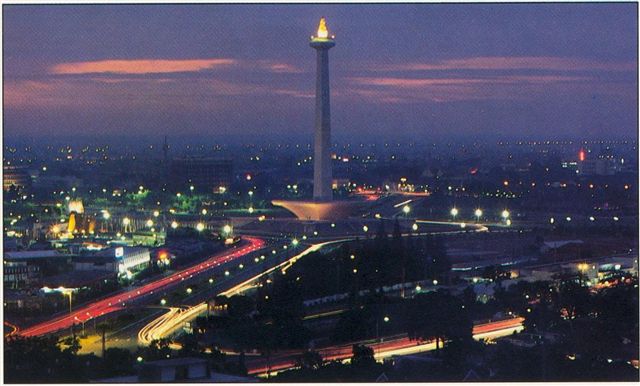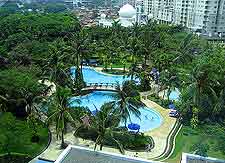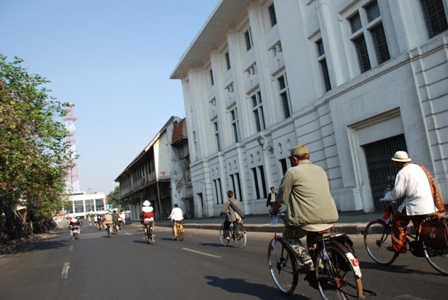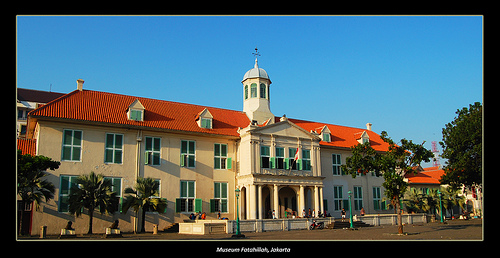
Foreign Representatives:
Embassy Name : Embassy of the Democratic Republic of AfghanistanAddress : Jl. Dr. Kusumaatmaja SH No. 15, Menteng, Jakarta Pusat 10310Phone 62-21) 314-3169, Fax 62-21) 335-390
Embassy Name : Embassy of the Democratic People's Republic of AlgeriaAddress : Jl. H. R. Rasuna Said Kav. 10-11, Kuningan, Jakarta Selatan 12950Phone 62-21) 525-4719, 525-4809, Fax 62-21) 525-4654Contact Mail :ambalyak@rad.net.id
Embassy Name : Embassy of the Republic of ArgentinaAddress : Menara Mulia Building, 19th floor, Jl. Jend. Gatot Subroto Kav. 9-11 Jakarta Selatan 12930Phone 62-21) 526-5661, 526-5662, Fax 62-21) 526-5664Contact Mail :embargen@cbn.net.id
Embassy Name : Embassy of AustraliaAddress : Jl. H.R. Rasuna Said Kav. C15-16, Kuningan, Jakarta Selatan 12940Phone 62-21) 2550-5555, Fax 62-21) 522-7101, 526-1690Contact Mail public.affairsjakt@dfat.gov.au
Embassy Name : Embassy of AustriaAddress : Jl. Diponegoro No. 44, Menteng, Jakarta Pusat 10310Phone 62-21) 338-090, 338-101, Fax 62-21) 390-4927Contact Mail :auambjak@rad.net.id
Embassy Name : Embassy of the People's Republic of BangladeshAddress : Jl. Denpasar Raya No. 3 Blok A13 Kav. 10, Kuningan, Jakarta Selatan 12950Phone 62-21) 525-1986, 522-1574, Fax 62-21) 526-1807Contact Mail :bdootjak@rad.net.id
Embassy Name : Royal Belgian EmbassyAddress : Deutsche Bank Building, 16th floor, Jl. Imam Bonjol No. 80, Menteng, Jakarta Pusat 10310Phone 62-21) 316-2030, Fax 62-21) 316-2035Contact Mail :jakarta@diplobel.org,
ambeljkt@rad.net.idWebsite :http://www.austembjak.or.
Embassy Name : Embassy of the Federative Republic of BrazilAddress : Menara Mulia Building, 16th floor, Jl. Jend. Gatot Subroto Kav. 9-11, Phone 62-21) 526-5656, 526-5657, 526-5658, Fax 62-21) 526-5659Contact Mail :brasemb@rad.net.id
Embassy Name : Embassy of Brunei DarussalamAddress : Wisma GKBI, Suite 1901, Jl. Jend. Sudirman Kav. 28, Jakarta Pusat 10210Phone 62-21) 574-1437-1469, 574-1470-1472, Fax 62-21) 574-1463
Embassy Name : Embassy of the People's Republic of BulgariaAddress : Jl. Imam Bonjol No. 34-36, Menteng, Jakarta Pusat 10310Phone 62-21) 390-4048, 390-4049, Fax 62-21) 315-1433
Embassy Name : Royal Embassy of CambodiaAddress : Jl. Kintamani Raya C-15 No. 33, Jakarta 12950Phone 62-21) 919-2895, Fax 62-21) 520-2673Contact Mail :recjkt@cabi.net.id
Embassy Name : Embassy of CanadaAddress : World Trade Centre, 6th Floor, Jl. Jend. Sudirman, Kav. 29, Jakarta 12920Phone 62-21) 525-0709, Fax 62-21) 571-2251Contact Mail :jkarta@dfait-maeci.gc.ca
Embassy Name : Embassy of the Republic of ChileAddress : Bina Mulia Building I, 7th floor, Jl. H.R. Rasuna Said Kav. 10, Kuningan, Phone 62-21) 520-1131, 520-1132, Fax 62-21) 520-1955Contact Mail :emchijak@rad.net.id, echij@rad.net.id
Embassy Name : Embassy of the People's Republic of ChinaAddress : Jl. Mega Kuningan 2, Karet Kuningan, Jakarta Selatan 12950Phone 62-21) 576-1039, Fax 62-21) 576-1034
Embassy Name : Embassy of the Republic of ColombiaAddress : Plaza Sentral, 16th floor, Jl. Jend. Sudirman Kav. 47, Jakarta Selatan 12920Phone 62-21) 525-6446, 570-1422, Fax 62-21) 520-7717Contact Mail :emcolin@rad.net.idWebsite :http://www.dfait-maeci.gc
Embassy Name : Embassy of CubaAddress : Taman Puri, Jl. Opal Blok K-1, Permata Hijau, Jakarta 12210Phone 62-21) 530-4293, Fax 62-21) 5367-6906Contact Mail :cubaindo@cbn.net.idWebsite :http://www.chinaembassy-i
Embassy Name : Royal Danish EmbassyAddress : Menara Rajawali, 25th Floor, Jl. Mega Kuningan Lot #5.1, Jakarta 12950, Phone 62-21) 576-1478, Fax 62-21) 576-1535Contact Mail :dkemb9@cbn.net.idWebsite :http://www.croatemb.or.id
Embassy Name : Representation of the European CommissionAddress : Wisma Dharmala Sakti, 16th floor, Jl. Jend. Sudirman Kav. 32, Jakarta Pusat 10220, (PO Box 6454, JKPDS Jakarta)Phone 62-21) 570-6076, Fax 62-21) 570-6075Contact Mail :delegation-indonesia@cec.eu.intWebsite :http://www.czech-embassy.
Embassy Name : Embassy of FranceAddress : Jl. M.H. Thamrin No. 20, Menteng, Jakarta Pusat 10310Phone 62-21) 314-2807, 314-3338, Fax 62-21) 392-9678Contact Mail :ambfrykt@uninet.net.id
Embassy Name : Embassy of the Federative Republic of GermanyAddress : Jl. M.H. Thamrin No. 1, Menteng, Jakarta Pusat 10310Phone 62-21) 390-1750, Fax 62-21) 390-1757Contact Mail :germany@rad.net.idWebsite :http://www.delidn.cec.eu.
Embassy Name : Embassy of the Republic of HungaryAddress : Jl. H.R. Rasuna Said Kav. X-3, Kuningan, Jakarta Selatan 12950Phone 62-21) 520-3459, 520-3460, Fax 62-21) 520-3461Contact Mail :huembjkt@rad.net.id
Embassy Name : Embassy of IndiaAddress : Jl. H.R. Rasuna Said Kav. S-1, Kuningan, Jakarta Selatan 12950Phone 62-21) 520-4150, 520-4152, 520-4157, Fax 62-21) 520-4160Contact Mail :eoiisi@indo.net.idWebsite :http://www.germanembjak.o
Embassy Name : Embassy of the Republic of IraqAddress : Jl. Teuku Umar No. 38, Menteng, Jakarta Pusat 10350Phone 62-21) 390-4067, 390-4068, 390-4069, Fax 62-21) 390-4066Contact Mail :iraqembi@rad.net.id
Embassy Name : Embassy of the Republic of ItalyAddress : Jl. Diponegoro No. 45, Menteng, Jakarta Pusat 10310Phone 62-21) 337-445, Fax 62-21) 337-422Contact Mail :italemba@rad.net.id, italemea@rad.net.idWebsite :http://www.eoijakarta.or.
Embassy Name : Embassy of JapanAddress : Menara Thamrin, 7-10th floors, Jl. M.H. Thamrin Kav. 3, Menteng, Jakarta Pusat 10350Phone 62-21) 324-308, Fax 62-21) 325-460
Embassy Name : Embassy of the Hashemite Kingdom of JordanAddress : Jl. Denpasar Raya Blok A-13 Kav. 01-02, Kuningan, Jakarta Selatan 12950Phone 62-21) 520-4400, 520-4401, Fax 62-21) 520-2447Contact Mail :jordanem@cbn.net.idWebsite :http://www.italambjkt.or.
Embassy Name : Embassy of the Republic of KoreaAddress : Jl. Jend. Gatot Subroto Kav. 57-58, Kuningan, Jakarta Selatan 12930Phone 62-21) 520-1915, Fax 62-21) 525-4159Website :http://www.embjapan.or.id
Embassy Name : Embassy of the Lao People's Democratic RepublicAddress : Jl. Patra Kuningan XIV No. 1A, Kuningan, Jakarta Selatan 12950Phone 62-21) 522-9602, 522-7862, Fax 62-21) 522-9601Contact Mail :laoemjkt@cabi.net.id
Embassy Name : Embassy of LebanonAddress : Jl. YBR V No. 82, Kuningan, Jakarta 12950Phone 62-21) 525-3074, 526-4306, Fax 62-21) 520-7121
Embassy Name : Embassy of LibyaAddress : Jl. Pekalongan No. 24, Menteng, Jakarta Pusat 10310Phone 62-21) 335-308, 335-754, Fax 62-21) 335-726
Embassy Name : Embassy of MalaysiaAddress : Jl. H.R. Rasuna Said Kav. X-6 No. 1-3, Kuningan, Jakarta Selatan 12950Phone 62-21) 522-4947, Fax 62-21) 522-4974Contact Mail :mwjkarta@indosat.net.id, kbmjkt@indosat.net.id
Embassy Name : Embassy of MaliAddress : Jl. Mendawai III No. 18, Kebayoran Baru, Jakarta 12130Phone 62-21) 720-8504, 726-8504, Fax 62-21) 722-9589Contact Mail :ambamali@indosat.net.id
Embassy Name : Embassy of the Republic of Marshall IslandsAddress : Jl. Brawijaya Raya No. 17, Jakarta 12160Phone 62-21) 724-8564, 724-8565, Fax 62-21) 724-8566Contact Mail :marshall@idola.net.id
Embassy Name : Embassy of MexicoAddress : Menara Mulia Building, Suite 2360, Jl. Jend. Gatot Subroto Kav. 9-11, Jakarta Selatan 12930Phone 62-21) 520-3980, Fax 62-21) 520-3978Contact Mail :embmexic@rad.net.id
Embassy Name : Embassy of the Kingdom of MoroccoAddress : Kuningan Plaza South Tower, Suite 512, Jl. H.R. Rasuna Said Kav. C11-14, Kuningan, Jakarta Selatan 12940Phone 62-21) 520-0773, 520-0956, Fax 62-21) 520-0586Contact Mail :sifamajakar@cbn.net.id
Embassy Name : Embassy of MozambiqueAddress : Wisma GKBI, 37th floor, Jl. Jend. Sudirman No. 28, Jakarta 10210Phone 62-21) 574-0901, Fax 62-21) 574-0907Contact Mail :embamoc@cbn.net.id
Embassy Name : Embassy of the Union of MyanmarAddress : Jl. H. Agus Salim No. 109, Menteng, Jakarta Pusat 10350Phone 62-21) 314-0440, 327-684, Fax 62-21) 327-204Contact Mail :myanmar@cbn.net.id
Embassy Name : Royal Netherlands EmbassyAddress : Jl. H.R. Rasuna Said Kav. S-3, Kuningan, Jakarta Selatan 12950, (P.O.Box 2439 JKT 10024)Phone 62-21) 525-1515, Fax 62-21) 570-0734Contact Mail :nlgovjak@attglobal.net
Embassy Name : New Zealand EmbassyAddress : Gedung BRI II, 23rd floor, Jl. Jend. Sudirman Kav. 44-46, Jakarta Pusat 10210Phone 62-21) 570-9460, Fax 62-21) 570-9457Contact Mail :nzembjak@cbn.net.id
Embassy Name : Embassy of the Federal Republic of NigeriaAddress : Jl. Taman Patra XIV No. 11A, Kuningan Timur, Jakarta Selatan 12950Phone 62-21) 526-0922, 526-0923, Fax 62-21) 526-0924Contact Mail :embnig@centrin.net.id
Embassy Name : Embassy of the Kingdom of NorwayAddress : Menara Rajawali Building, 25th floor, Kawasan Mega Kuningan Lot 5.1, Jakarta Selatan 12950Phone 62-21) 576-1523, 576-1524, Fax 62-21) 576-1537Contact Mail :emb.jakarta@mfa.no
Website :http://www.netherlandsembEmbassy Name : Embassy of PalestineAddress : Jl. Diponegoro No. 59, Menteng, Jakarta Pusat 10310Phone 62-21) 314-5444, 323-521, 310-6546, 323-521, Fax 62-21) 310-8011
Embassy Name : Embassy of PanamaAddress : World Trade Center, 13th floor, Jl. Jend. Sudirman Kav. 29-31, Jakarta 12920Phone 62-21) 571-1867, 570-0218, 521-1821, Fax 62-21) 571-1933Website :http://www.norwayemb-indo
Embassy Name : Embassy of PeruAddress : Bina Mulia Building II, 3rd Floor, Jl. H.R. Rasuna Said Kav. 11, Kuningan, Jakarta Selatan 12950Phone 62-21) 520-1866, 520-1176, Fax 62-21) 520-1932Contact Mail :embaperu@indo.net.id or embaperu@cbn.net.id
Embassy Name : Embassy of the Republic of the PhilippinesAddress : Jl. Imam Bonjol No. 6-8, Menteng, Jakarta Pusat 10310Phone 62-21) 315-5118, 3109-2789, Fax 62-21) 315-1167, 314-9773Contact Mail phjkt@indo.net.id
Embassy Name : Embassy of the Republic of PolandAddress : Jl. H.R. Rasuna Said Kav. X Blok IV3, Kuningan, Jakarta 12950Phone 62-21) 252-5938/9, 252-5940/42, Fax 62-21) 252-5958Contact Mail plembjkt@rad.net.id
Embassy Name : Embassy of PortugalAddress : Bina Mulia Bldg I, 7th floor, Jl. H.R. Rasuna Said Kav. X, Kuningan, Jakarta 12950Phone 62-21) 526-5103, 526-5105, 526-5106, Fax 62-21) 527-1981Contact Mail porembjak@attglobal.net
Embassy Name : Embassy of the State of QatarAddress : Jl. Taman Ubud I No. 5, Kuningan Timur, Jakarta 12920Phone 62-21) 527-7751, 527-7752, Fax 62-21) 527-7754Contact Mail :qataremj@rad.net.id
Embassy Name : Embassy of RomaniaAddress : Jl. Teuku Cik Ditiro No. 42A, Menteng, Jakarta Pusat 10310Phone 62-21) 310-6240, 310-6241, Fax 62-21) 390-7759Contact Mail :ambromin@indosat.net.id
Embassy Name : Embassy of the Russian FederationAddress : Jl. H. R. Rasuna Said Kav. 7 No. 1-2, Kuningan, Jakarta Selatan 12950Phone 62-21) 522-2912, 522-2914, Fax 62-21) 522-2916, 522-2915Contact Mail :rusembjkt@dnet.net.id
Embassy Name : Embassy of the Kingdom of Saudi ArabiaAddress : Jl. M.T. Haryono Kav. 27, Cawang Atas, Jakarta Timur 13630Phone 62-21) 801-1533, 801-1536, 801-1537, Fax 62-21) 801-1527
Embassy Name : Embassy of the Republic of SingaporeAddress : Jl. H.R. Rasuna Said Kav. X-4 No. 2, Kuningan, Jakarta Selatan 12950Phone 62-21) 5296-1433, 520-1489, Fax 62-21) 520-2320Contact Mail :denpasar@pacific.net.id
Embassy Name : Embassy of the Slovak RepublicAddress : Jl. Prof. Moh. Yamin SH No. 29, Menteng, Jakarta Pusat 10310Phone 62-21) 310-1068, 315-1429, Fax 62-21) 310-1180Contact Mail :slovemby@indo.net.id
Embassy Name : Embassy of South AfricaAddress : Wisma GKBI, Suite 705, Jl. Jend. Sudirman Kav. 28, Jakarta Pusat 10210Phone 62-21) 574-0660, Fax 62-21) 574-0661Contact Mail :saembjak@centrin.net.id
Embassy Name : Embassy of the Kingdom of SpainAddress : Jl. H. Agus Salim No. 61, Menteng, Jakarta Pusat 10350Phone 62-21) 335-0771, 335-940, Fax 62-21) 325-996Website :http://www4.gov.sg/mfa/jk
Embassy Name : Embassy of the Republic of the SudanAddress : Wisma Bank Dharmala, 7th floor, Suite 1, Jl. Jend. Sudirman Kav. 28, Jakarta Selatan 12910Phone 62-21) 521-2075, Fax 62-21) 521-2077Contact Mail :sudanjak@indosat.net.idWebsite :http://www.saembassy-jaka
Embassy Name : Embassy of SwitzerlandAddress : Jl. H.R. Rasuna Said Kav. X3-2, Kuningan, Jakarta Selatan 12950Phone 62-21) 525-6061, Fax 62-21) 520-2289Contact Mail :swiemjak@rad.net.id, vertretung@jak.rep.admin.ch
Embassy Name : Embassy of the Syrian Arab RepublicAddress : Jl. Karang Asem I No. 8, Kuningan Raya, Jakarta Selatan 12950Phone 62-21) 525-5991, 520-4117, 520-1641, Fax 62-21) 520-2511
source: indonesia.travel






































 Rice is most often eaten as plain rice (nasi putih) with just a few protein and vegetable dishes as side dishes. It is also served, however, as ketupat (rice steamed in woven packets of coconut fronds), lontong (rice steamed in banana leaves), intip (rice crackers), desserts, vermicelli, noodles, brem (rice wine), and nasi goreng (fried rice).Rice was only incorporated into diets, however, as either the technology to grow it or the ability to buy it from elsewhere was gained.
Rice is most often eaten as plain rice (nasi putih) with just a few protein and vegetable dishes as side dishes. It is also served, however, as ketupat (rice steamed in woven packets of coconut fronds), lontong (rice steamed in banana leaves), intip (rice crackers), desserts, vermicelli, noodles, brem (rice wine), and nasi goreng (fried rice).Rice was only incorporated into diets, however, as either the technology to grow it or the ability to buy it from elsewhere was gained. In the sixteenth century, Europeans visiting the Indonesian islands saw rice as a new prestige food served to the aristocracy during ceremonies and feasts.Rice production requires exposure to the sun. Rice production in Indonesian history is linked to the development of iron tools and the domestication of Wild Asian Water Buffalo as water buffalo for cultivation of fields and manure for fertilizer.
In the sixteenth century, Europeans visiting the Indonesian islands saw rice as a new prestige food served to the aristocracy during ceremonies and feasts.Rice production requires exposure to the sun. Rice production in Indonesian history is linked to the development of iron tools and the domestication of Wild Asian Water Buffalo as water buffalo for cultivation of fields and manure for fertilizer. The peanut thrived in the tropical environment of Southeast Asia, and today, they can be found roasted and chopped finely, topping a variety of dishes and in marinades and dipping sauces. Peanut sauce reach its sophistication in Indonesia, with the delicate balance of taste acquired from various ingredients according to each recipe of peanut sauce; fried peanuts, gula jawa (coconut sugar), garlic, shallot, ginger, tamarind, lemon juice, lemongrass, salt, chilli, pepper, sweet soy sauce, grinded together and mixed with water to acquire right texture.
The peanut thrived in the tropical environment of Southeast Asia, and today, they can be found roasted and chopped finely, topping a variety of dishes and in marinades and dipping sauces. Peanut sauce reach its sophistication in Indonesia, with the delicate balance of taste acquired from various ingredients according to each recipe of peanut sauce; fried peanuts, gula jawa (coconut sugar), garlic, shallot, ginger, tamarind, lemon juice, lemongrass, salt, chilli, pepper, sweet soy sauce, grinded together and mixed with water to acquire right texture. The extensive uses of coconut milk especially found in Minangkabau cuisine, while in Minahasan (North Sulawesi) cuisine, coconut milk rather absent except for Minahasan cakes and desserts such as klappertart. In Indonesian cuisine, coconut milk can be found in two type, thin coconut milk and thick coconut milk, the difference is depends on the amount of water in it. Thin coconut milk usually being use for soups such as sayur lodeh and soto, while creamy thick one use for rendang and desserts. It can be acquired freshly from shredded coconut flesh in traditional market, to processed coconut milk in carton packages at supermarket.
The extensive uses of coconut milk especially found in Minangkabau cuisine, while in Minahasan (North Sulawesi) cuisine, coconut milk rather absent except for Minahasan cakes and desserts such as klappertart. In Indonesian cuisine, coconut milk can be found in two type, thin coconut milk and thick coconut milk, the difference is depends on the amount of water in it. Thin coconut milk usually being use for soups such as sayur lodeh and soto, while creamy thick one use for rendang and desserts. It can be acquired freshly from shredded coconut flesh in traditional market, to processed coconut milk in carton packages at supermarket. After the juice (milk) being extracted from shredded coconut flesh to acquire coconut milk, the ampas kelapa (leftover coconut flesh) still can be used as urap, seasoned and spiced shredded coconut flesh mixed together with vegetables.
After the juice (milk) being extracted from shredded coconut flesh to acquire coconut milk, the ampas kelapa (leftover coconut flesh) still can be used as urap, seasoned and spiced shredded coconut flesh mixed together with vegetables.
 Street and street-side vendors are common, in addition to hawkers peddling their goods on bicycles or carts. These carts are known as pedagang kaki lima - (named after the 5-foot (1.5 m) wide footpaths in Indonesia, however some people say they are named 'five feet' after the three feet of the cart and two feet of the vendor!), and many of these have their own distinctive call or songs to announce their wares. For example, the bakso seller will hit the side of a soup bowl, whereas mie ayam is announced by hitting a wood block.
Street and street-side vendors are common, in addition to hawkers peddling their goods on bicycles or carts. These carts are known as pedagang kaki lima - (named after the 5-foot (1.5 m) wide footpaths in Indonesia, however some people say they are named 'five feet' after the three feet of the cart and two feet of the vendor!), and many of these have their own distinctive call or songs to announce their wares. For example, the bakso seller will hit the side of a soup bowl, whereas mie ayam is announced by hitting a wood block. Many of these fruits such as Mangosteen, Rambutan, Jackfruit, Durian, and Banana, are indigenous to Indonesian archipelago; while others have been imported from other tropical countries, although the origin of many of these fruits might be disputed. Banana and Coconut are particularly important, not only to Indonesian cuisine, but also in other uses, such as timber, bedding, roofing, oil, plates and packaging, etc.
Many of these fruits such as Mangosteen, Rambutan, Jackfruit, Durian, and Banana, are indigenous to Indonesian archipelago; while others have been imported from other tropical countries, although the origin of many of these fruits might be disputed. Banana and Coconut are particularly important, not only to Indonesian cuisine, but also in other uses, such as timber, bedding, roofing, oil, plates and packaging, etc.





